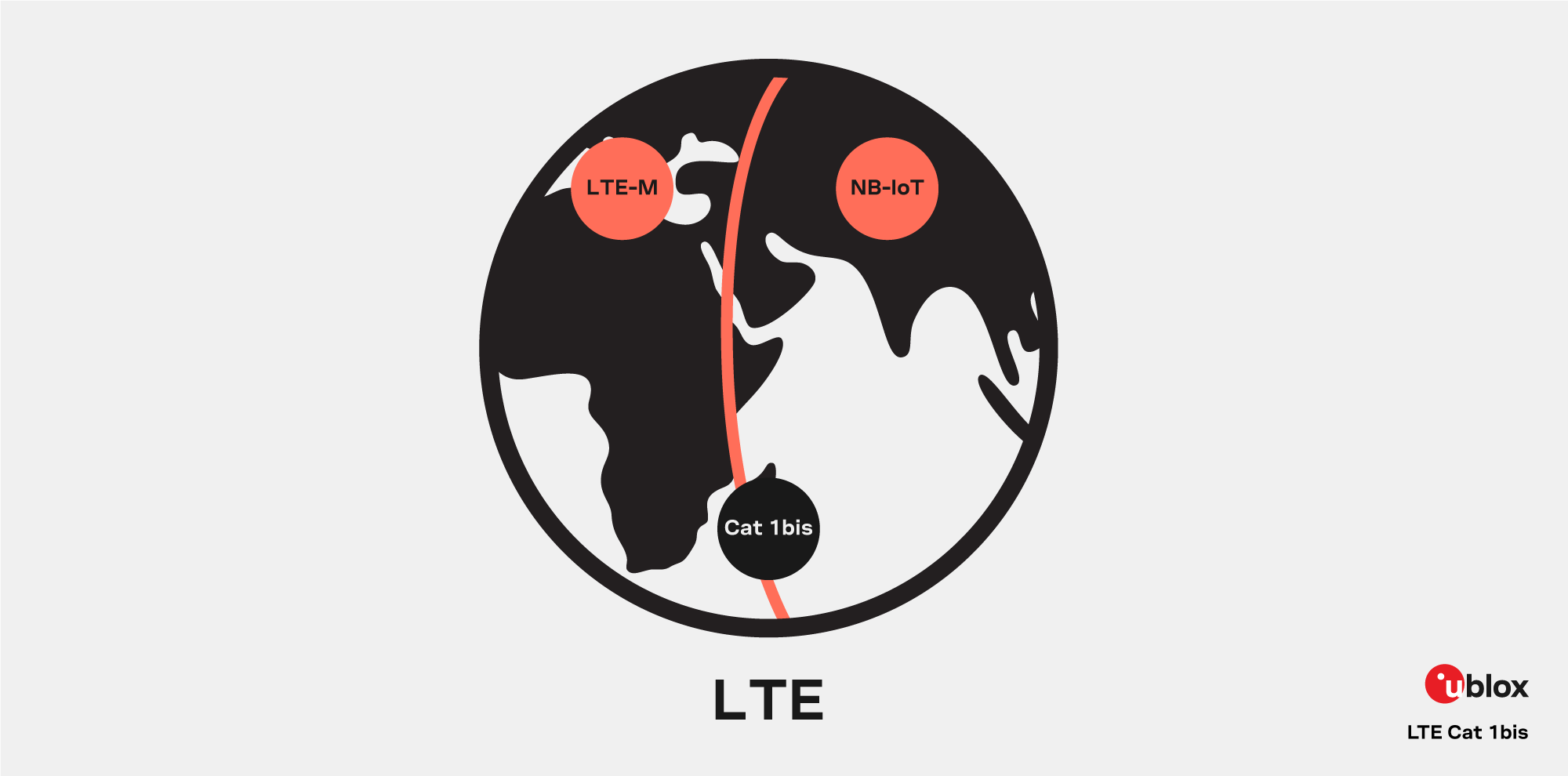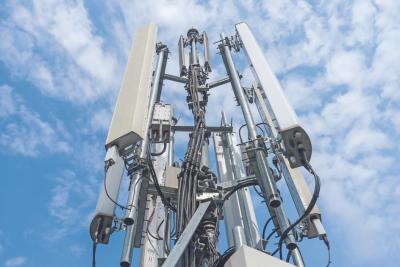
- Support portal
- Evaluation Kits and partner products
u-blox Support
- Product documentation
Documentation
- Investor relations
Investor relations
Insights
|
15 May 2024
An option for Low Power Wide Area (LPWA) applications

The IoT ecosystem is experiencing a revolutionary phase. Most Mobile Network Operators (MNOs) have announced or even executed the switch-off of legacy 2G and 3G cellular technologies, migrating the related frequencies to 4G or 5G networks. As a result, IoT developers must also adopt a new cellular standard.
Although 5G is already under deployment, its use faces several challenges. Besides limitations in global coverage, current 5G solutions don't meet most IoT requirements: high power consumption, cost, size, and design complexity are some of the drawbacks. 5G RedCap and MMTC are expected to address these issues in the future. For now, 4G LTE is the only cellular technology that provides ubiquitous global coverage and can play this role for at least the next five years.
In 2016, 3GPP Rel 13 specified new 4G cellular standards for the IoT. The aim was to compete with non-cellular Low Power Wide Area (LPWA) technologies, like SigFox or LoRaWAN. The new cellular standards that 3GPP launched were NB-IoT (aka LTE Cat-NB), LTE-M (aka LTE Cat-M), and LTE Cat 1bis (3GPP Rel 8 had already specified the LTE Cat 1 standard).
Following 3GPP Rel 13, MNOs and chip manufacturers focused on NB-IoT and LTE-M, leaving aside LTE Cat 1bis. This decision was made because, comparing specs, the Cat 1bis pros/cons ratio was less favorable than the other two.
An intense debate arose around the new proposed cellular LPWA technologies for the IoT. One side pushed toward using NB-IoT, while the other toward LTE-M as in the past, countries could independently agree on deployed technology, supported bands, and roaming agreements.
But apart from a few exceptions like IMT-2000’s early rollout in Japan or the initial deployment of CDMA/EV-DO in North America before converging to UMTS/HSPA, the world was under global convergence.
More recently, that convergence was left out of the picture. APAC and most of EMEA chose NB-IoT implementations, while the Americas, Japan, South Korea, and Australia chose LTE-M.
The divergence created a bipolar world. China pushed hard for NB-IoT; indeed, China is the only country where NB-IoT has had a massive deployment. North America, on the other hand, deployed LTE-M quickly. Today, LTE-M dominates most of this market, although some MNOs have added NB-IoT support over the years. EMEA’s case is peculiar. Initially, it opted for NB-IoT. Later, however, most MNOs in Western European countries also added LTE-M support.
While LTE-M characteristics fit most IoT requirements, this is not true for NB-IoT. Even if NB-IoT has better MCL (Maximum Coupling Loss) than LTE-M, its data rate is limited. In addition, the design of NB-IoT infrastructure does not support mobility (handover) and voice.
In the current scenario, we find regions where IoT applications benefit from excellent LTE-M coverage (like North America), whereas in others, it's partially or entirely absent. When the latter situation happens, NB-IoT cannot satisfy most use cases due to the abovementioned limitations.
In Europe, many IoT applications still connect to legacy 2G (where available). Customers ask for LPWA modules with 2G fallback because LTE-M coverage is unreliable and, in worst cases, absent. NB-IoT capabilities do not fulfill use case demands.
Until recently, LTE Cat 1 was the lowest-cost 4G cellular technology with global coverage. A drawback of LTE Cat 1 is that its chipsets cost much more than those for NB-IoT or LTE-M. Moreover, an LTE Cat 1 design is more complex and requires additional components compared to LTE-M and NB-IoT, which significantly impacts the overall cost.

This situation has led IoT developers and MNOs to search for cost-effective alternatives and thus guarantee LPWA worldwide connectivity, mobility, and roaming for the IoT ecosystem — resulting in a renewed interest in LTE Cat 1bis.
In a nutshell, LTE Cat 1bis is LTE Cat 1 with a single receive (Rx) antenna. All the other device characteristics, like uplink (UL) / downlink (DL) data rates and protocols, remain the same. On the contrary, standard LTE Cat 1 (3GPP Rel 8) supports Rx diversity and requires two Rx paths.
Rx diversity improves RF reception capabilities, especially at the edge of the cell. But to support Rx diversity, the LTE Cat 1 chipsets require two RF inputs with a sophisticated RF front-end and specific software. To some extent, this is why LTE Cat 1 chipsets cost more than those for LTE-M and NB-IoT, and why LTE Cat 1 applications require more elaborated and extensive PCBs, additional components, and two antennas. All these features result in higher costs: an LTE Cat 1 solution could cost twice as much as its LTE-M counterpart.
Removing the Rx diversity feature from the LTE Cat 1bis standard enables simpler, cost-optimized chipset designs. Developers are taking advantage of this to design simpler, smaller, and cheaper IoT applications than they could with the LTE Cat 1 standard.
Comparing LTE-M and LTE Cat 1bis, both can be suitable technology choices for IoT applications, depending on the region and use case. There are several reasons for this:
To summarize, both LTE Cat 1bis and LTE-M meet the requirements of most IoT use cases previously served by 2G and 3G technologies: medium bandwidth, low power consumption, and low cost, among others.
Why consider LTE Cat 1bis as an LPWA alternative now? What driving factors could lead IoT developers to ponder LTE Cat 1bis as an LPWA option? We must consider the specific use case, price gap, and status of LPWA global deployments to answer these questions. When choosing the proper communication technology, four considerations are at stake. The following is a brief but by no means exhaustive list:
We must consider that IoT applications like video surveillance, alarm systems with video, or eHealth, produce considerable data volume. These use cases could leverage LTE Cat 1bis operators with 20 MHz bandwidth compared to 1.4 MHz for LTE-M.
With more bandwidth, devices can transmit data faster. This translates into less time in the air and, consequently, less battery usage. Depending on the amount of data, faster transmission means less time in the air, resulting in better power efficiency.
The global portability provided by legacy 2G and 3G technologies is ending due to the sunset of cellular standards in many countries. LPWA technologies such as LTE-M and NB-IoT have been deployed without much coordination, creating a peculiar global situation. APAC and most Eastern European countries have only NB-IoT coverage, whereas the Americas, Australia, and a few European countries have both NB-IoT and LTE-M. Although in this latter case, the coverage faces several obstacles.4G LTE is present in most African countries where neither NB-IoT nor LTE-M has been deployed. The exception to the rule is South Africa, where NB-IoT is currently active.
Roaming agreements should also be considered. They are scarce, and there is no guarantee that an IoT device traveling between countries will have network access, even if there is sufficient coverage in both locations.
Consider Italy as an example, although this applies to other Western European countries as well. Italian MNOs, like most European MNOs, initially deployed NB-IoT. But in recent times, Vodafone Italy added LTE-M support (2022). This does not necessarily mean that LTE-M is available everywhere, especially considering that the NB-IoT coverage is not comprehensive. So even if LTE-M is available, the Italian territory lacks full coverage with no certainty when this will be achieved.
Another example is the United States, where LTE-M has been extensively deployed with good coverage across most of the country, resulting in a large installed base of LTE-M IoT devices. Yet, NB-IoT has been less prioritized. Although US MNOs have deployed NB-IoT networks, the installed base is much smaller compared to LTE-M.
LTE Cat 1bis is available wherever there is a 4G LTE network, which is the case in most populated parts of the world. Roaming between 4G networks is largely possible under existing agreements, making LTE Cat 1bis particularly suitable for mobile applications such as telematics and asset tracking. Examples like this could encourage IoT developers to consider LTE Cat 1bis as a viable LPWA option.
Currently, it is difficult to say which technology, LTE Cat 1bis or LTE-M, will have a longer lifespan. The MNOs have not announced any sunset plans for either technology, and the timing is likely to vary from region to region.
Some markets, like the United States and some APAC countries, may transition to 5G more quickly. This could incentivize network operators to shift from the current 4G spectrum to 5G. Factors to consider may include the number of legacy devices on their networks, the bandwidth each technology consumes, and which bands will be prioritized for the transition. Other markets, however, will move much more slowly and may keep both technologies alive well into the late 2030s.
LTE-M has a Maximum Coupling Loss (MCL) of -154 dBm compared to -149 dBm for LTE Cat 1. LTE Cat 1bis experiences an additional 3-4 dB loss compared to Cat 1 due to the absence of the Rx diversity antenna. This means that the MCL of LTE Cat 1bis is 8-9 dBm worse than LTE-M. The higher MCL of LTE-M ensures better connectivity in challenging signal conditions, such as harsh urban environments, garages, or at the cell edge. However, LTE-M’s deeper signal penetration is partially offset by its lower cell density compared to standard 4G LTE.
Developers find it hard to address some use cases, even considering the current miniaturization of electronic components. LTE Cat 1 ticks many boxes for use cases like wearables that require small size and medium data rates, offering advantages in terms of bandwidth, coverage, and power consumption. Still, miniaturization has been challenging due to the need for a dual-antenna design.
The fact that designers aim for small solutions forces them to find the equilibrium between performance and size. Consequently, many current small form factor LTE Cat 1 designs omit Rx Diversity and do not include a second antenna.
With its simplified antenna, shorter parts list, and more affordability (compared to LTE Cat 1), LTE Cat 1bis can also replace LTE Cat 1 in many use cases.
Both LTE Cat 1bis and LTE-M are suitable technology choices for LPWA applications. So before making a choice, one must consider technology characteristics and regional deployment. One may be a better candidate than the other, or maybe both could be considered. u-blox can assist with this type of selection, depending on specific use cases and MNOs.
u-blox offers a broad portfolio, including LTE-M, LTE Cat 1, and LTE Cat 1bis modules. u-blox established early market leadership in LTE-M with the first certified LTE-M module series, SARA-R4, which also offers 2G fallback. u-blox also developed its own LTE-M chipset, the UBX-R5, which was used as the basis for the u-blox SARA-R5 module series. Both series have been further miniaturized into the LEXI-R4 and LEXI-R5 form factors.
For LTE Cat 1bis, u-blox offers the LENA-R8 and LEXI-R10 series. LENA-R8 is also available as a combo: LTE Cat 1bis + GNSS variant. The GNSS core is the new u-blox M10 GNSS platform. The LENA-R8 combo (LENA-R8M10) has two power supplies, providing customers with excellent power management flexibility, thus optimizing the overall performance. LEXI-R10 is the world’s smallest LTE Cat 1bis module supporting Wi-Fi scanning and CellLocate for indoor positioning. The u-blox LARA-R6 LTE Cat 1 module supports full Rx diversity and is best suited for high-performance applications.

Valerio Carta
Senior Product Marketing Manager Cellular